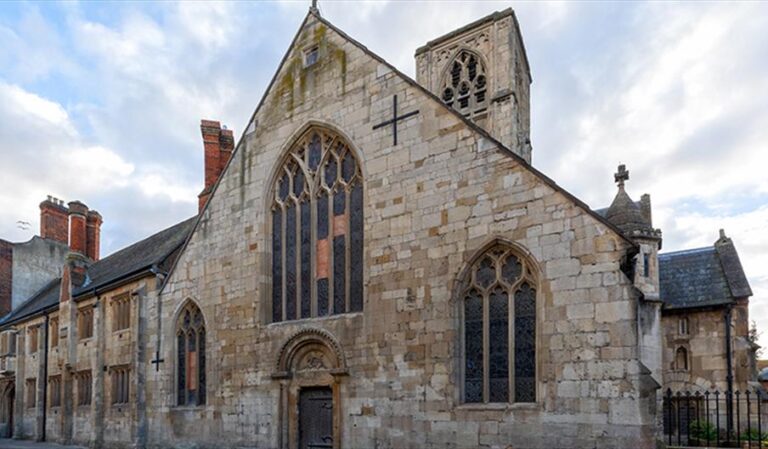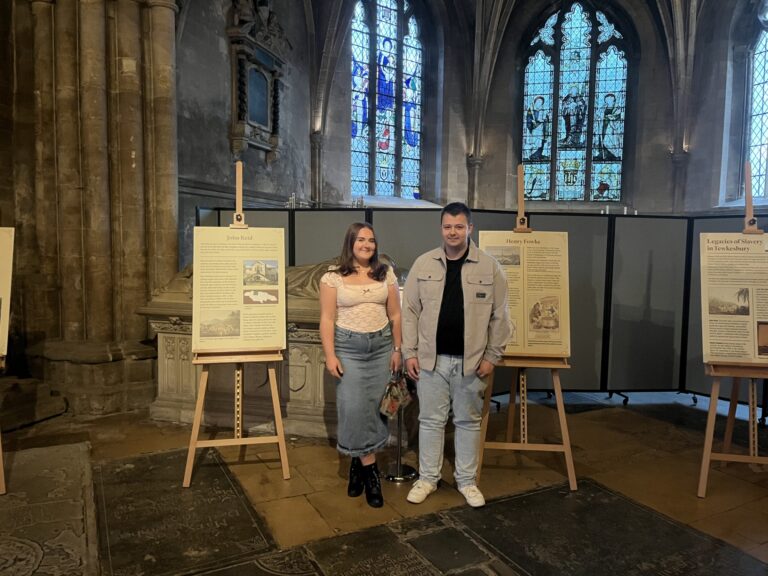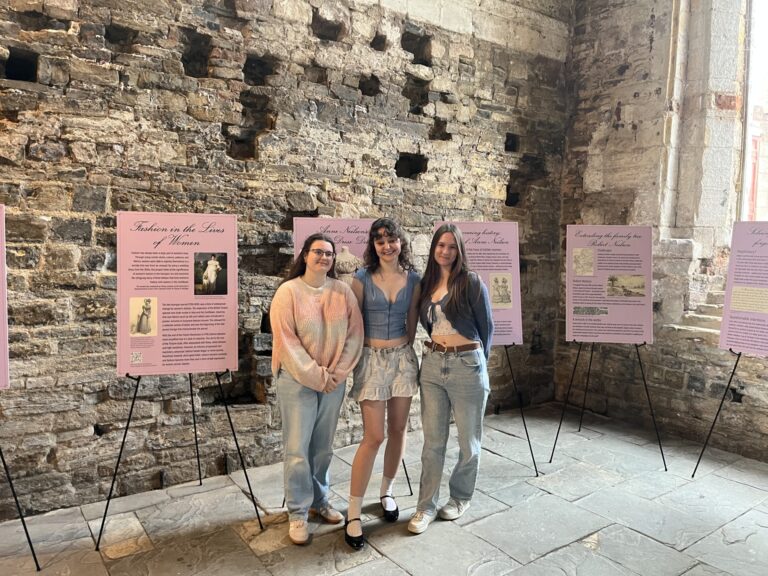| CC4HH
Life in Cheltenham’s workhouses
Project conducted by Owen Adams, Carla Walker and Kelly Rimmer.
Exhibited at Chapel Arts in Cheltenham, September 2019 as part of the Gloucester History Festival 2019.
Jump to: Introduction | Inside the workhouse | ‘Reign of Terror’ 1874 | Escaping the workhouse | One-way tickets to Quebec
What was the workhouses system?
While state-sponsored poor relief existed from the early 17th century, the rise in poverty during the early 19th century forced the government to create the workhouse system through the Poor Law Amendment Act, 1834. Designed to be grim, the workhouse was not to be seen as a soft option, but a deterrent. The Royal Commission Report (1834) described poverty as being caused ‘from unemployment, the mal-distribution of labour, and the misuse of wages’ and ‘from individual immorality and fecklessness encouraged by public poverty’ – thus the fault of the poor.
Conditions varied across the country and over time, but masters and guardians had a legal duty of care towards the ‘inmates. Workhouses were not only intended for the poor, but other minority groups in need, such as orphans, widowed and unmarried mothers, the disabled, the mentally ill, and the elderly.
Workhouses in Cheltenham
Early 19th century Cheltenham grew rapidly in size, from only 710 houses in 1801 to over 6000 by 1836. The Regency-era Spa’ boom attracted those seeking employment in the building trade and in domestic service. Soon, the number of people arriving began to outstrip labour demand. The population grew from 3076 in 1801 to 35,051 in 1851; as the population expanded, so did unemployment and poverty. One of the first workhouses was located on the Lower High Street, followed by another on the site of St Gregory’s Catholic School on Knapp Lane, which operated between 1809-1850. A purpose-built workhouse was opened on Swindon Road in 1841 (pictured below).

Poverty in ‘Regency’ CHeltenham
Social reformer Josephine Butler campaigned to improve conditions for disadvantaged women. She described poverty in Cheltenham in the 1860s: “There are low class brothels and slums which would be a disgrace to London or New York; 12 or 13 of a family in one room, grown ups and children, girls of 15 carrying their own babies in their arms like bundles of rags”.

Inside the workhouse
Information on life inside Cheltenham’s workhouses is not easy to find. The daily routine was very strict: early starts, long working hours, set meal times, religious meetings and early bed time. Accommodation was cramped and bed sharing was common. Meals were completed in silence, and, under threat of punishment, rules were not to be broken.
Food was limited and unappealing. Every inmate was given the same amount. As time went on portions became larger and the food was more varied: cooked fish was even added to some daily diets. An 1874 report outlines the appalling problems of starvation and poor food quality in Cheltenham’s workhouse:
“the ‘beef broth was ‘sour and horrible in appearance… not only different from ordinary beef tea… but is simply… a decoction of chondrine or gristle from bones, which appear to have been cleanly picked of everything that is valuable… Aged and infirm inmates were fed ‘boiled pigs’ lights and pipes, sometimes with lumps of fat pork. Even the potatoes were ‘too disgusting in taste and smell to be eatable… very frequently the dinners were untouched and food went back to the kitchen”.
Children made up a considerable proportion of the inmates. Cheltenham residents often felt sorry for children, and there were a number of charitable organisations to help, such as a ‘Ragged School’ in Milsom Street.
Letter from the Cheltenham court, 28/11/1890:
“poor child eleven years of age being brought before the Court this day on a charge of wandering about without visible means of subsistence and it is ordered by the court that the said Herbert Bungay be sent to the Cheltenham Union Workhouse to be there detained until Thursday next to be brought before the Board of Guardians in order that such steps may be taken for the future care of the said child as may be deemed necessary”.
‘reign of terror’ 1874
In 1874 reports of awful conditions emerged from the Workhouse Guardian Mr Onley reported inmates were often complaining that they did not receive as good food as they did in jail, and that the Matron, Hyacinthe Welch, was waging a campaign of bitterness and terrorism’ against inmates and staff.
Scandalous neglect of workhouse inmates
The porter, mechanic, schoolmistress and nurse resigned in quick succession because of ‘continual bullying from the Matron and her husband. William Welch, the Master, and also inedible food. A public inquiry followed the internal investigation- a picture emerged of drunkenness, drug-taking, theft and neglect of inmates; workhouse managers helped themselves to the stores, and entertained their friends.
The select few who ate at the Master’s table enjoyed lean pork sausage, eggs and chickens that were fed on workhouse grain supplies. Milk was “scalded and re-scalded”, skimmed to make butter and cream for the household. The poor quality residue was given to inmates and may have been responsible for children’s skin diseases. Elderly paupers did not receive any milk or sugar in their tea.
The Welches regularly stayed out late, leaving the workhouse open and unguarded. The Master admitted he failed to check on elderly and infirm inmates “as it was most odious for him to be expected to go into wards where old people are shut up, with every breath of air excluded, and that it could do no possible good for him to go through badly-smelling rooms”.

Inhumane punishment cells condemned
The Master failed to record punishments. In March 1875 a government inspector condemned at Cheltenham Union Workhouse, “cells in which refractory [unmanageable] inmates are placed in confinement are below the surface of the ground, have brick floors, and are cold, damp and perfectly dark. Sir Brydges Henniker is of opinion that under these circumstances such punishment must be very severe, especially for women, and he recommends that the cells in question should not be used for the purpose”.
Medicinal alcohol had been swapped for cheap port, and the porter regularly raided the drugs cabinet for large quantities of a stimulant known as tincture of cardamons, the mechanic and master were caught drunkenly fighting and were locked in the kitchen and office by the matron to keep them apart.
Master and matron refused to quit
The master pocketed proceeds from selling lard, rags and bones, and also kept the possessions of dead paupers; the porter failed to pass on money from paupers’ friends. William Welch admitted most of the charges, but the Board of Guardians was split on whether to give the Welches a second chance. The Welches publicly refused to resign, claiming these minor discrepancies did not warrant dismissal, and they were backed by half of the Guardians. They were finally forced to quit by a Government inspector.
No immediate signs of improvement
Did a new workhouse master improve conditions? It appears not, as 42 Cheltenham inmates wrote to the Poor Law Board in London in January 1876:
We the men of the old men’s ward have great complaint to you. We have done so to the guardians of this Union, and also to the Master and Matron, but they have not taken any notice of it. In the first place our tea is very bad having neither milk nor sugar and very little the taste of tea-secondly our pudding we should say has not more than three pounds of suet in it for more than three hundred persons and thirdly the pea soup it has not a morsel of meal in it-we are now compelled to appeal to you to take our case into your paid consideration and we shall be very thankful and fourthly the butter we are allowed is only five ounces while all other Unions are allowed seven ounces.
Escaping the workhouse
The workhouse trap
For many, especially single mothers, the aged, infirm or disabled, it was practically impossible to leave. Some were born and some died there. In 1874, in the Cheltenham Chronicle “[t]he death was reported of an old man named Burgess who had been 40 years in the present and old Workhouse. Taking his cost at 5s a-week, the Master said he had cost the ratepayers £520”.
Even after the workhouse system was dismantled in 1948, the NHS was still obliged to care for remaining inmates with nowhere to else go on the Swindon Road site. Children had more means of escaping the workhouse through education apprenticeships, adoption, or assisted emigration to the British colony in Canada, as did families.
Emigration to Quebec
emigrated from Cheltenham Workhouse to North America, on three April crossings from Gloucester to Quebec. From 1849, new government regulations encouraged assisted emigration to recruit workforces in British colonies, especially South Australia and British North America (Canada). Cheltenham Poor Law Union entered into an arrangement with Gloucester timber importers Messrs. Price & Co. to take paupers on cargo barques and ships, as steerage (between decks) passengers for less than £5 each to the Port of Quebec.

New regulations – intended to halt the practice of unscrupulous landlords from dumping starving evicted tenants without provisions in ‘coffin ships’ and sending them to America- stated that paupers had to be equipped with sufficient food, water, two sets of new clothes, bedding a Bible and £1 each to allow them to travel onwards to find work or be assigned work by a Colonial agent. Surplus to requirements in their home country, paupers were needed in this ‘land of milk and honey, with nobody to gather it’. Cheltenham Journal reported that ‘two females declined to go, as they had heard that Quebec was very cold and infested by wild beasts’.
Charity and the Church

In 1839, the Rev Francis Close. Cheltenham’s evangelical Anglican vicar, preached that ‘drowsiness’ and alcohol were responsible for pauperism, but in 1850 he conceded paupers were a surplus labour force, a side-effect of economic development. He spearheaded the emigration drive.
Image: Frances Close, by John Richardson Jackson (1850) National Portrait Gallery, London NPGD33534
It was only due to tireless fundraising campaigns and appeals to the gentry by the town’s John Russell, a pew opener, greengrocer and parish constable, that paupers were able to depart fully equipped as required by government regulations, as parish ratepayers would not cover the costs.
Mass emigration attracted public interest; before the first sailing in April 1850, those 244 about to set sail were treated to a charity rea and cake event at the Town Hall then in Regent Street.
Cheltenham Examiner reported: “The emigrants were neatly and cleanly clad, and all men, women, and children, were able to show that the thoughts of leaving home and not entirely taken away their appetites. They did ample justice to the good things placed before them”.
The Rev. Frances Close delivered a bittersweet farewell address from, as reported by Cheltenham Chronicle:
There is something so painful, something so touching, in looking at anything for the last time, and feeling we say Good-bye, never to meet again in this world… Honest hearts and hard working hands were wishing to labour but could not. He grieved that this was so. Again, here was Cheltenham, which had no high chimneys except the one at the salt manufactory, with forty thousand people in the place, and the other day it was only a small country village. What is to be done? When all the houses are built, and there are no more to be erected, our labourers must seek for work elsewhere… Their labour and skill was their capital, but he hoped that in going to a market for the good of their bodies, they would not be going to one where their souls would starve.
One-way tickets to Quebec
Four weddings and a funeral
Four couples were hastily married two days before departure, possibly as unmarried women with children did not meet the criteria for assisted emigration. People came from all directions at 6am to see the passengers leave Cheltenham in a chartered train of record length, which took them to within yards of the ‘fast ship’ Corsair at Gloucester Docks, where there were more well-wishers. Artillery was fired to salute the ship’s departure. Many people, including one breathless reverend performing divine service on the move, followed the ship as it was towed down the canal towards Sharpness Point by horses, and ‘a brisk peppering of oranges and apples was kept up for some time by those on shore to their friends on board’.

There were two births on the first voyage-the first while it was still being towed down the canal-and one death of an infant. It was confirmed that ‘the government have appointed a responsible agent at Quebec to see to the comfort of the emigrants at landing, and to direct those who behave themselves well on the voyage as to the best means of obtaining situations’.
Not all plain sailing
Some of the emigrants on the voyage felt and complained too of the strict discipline on board, but we all afterwards saw it was highly necessary, and gladly confess the benefit derived from acting to it through the voyage.
The Captain may justly complain -taking the steerage passengers altogether, he had a bad lot to control; not but that there were a good many well disposed people amongst us, and will do justice to the kindness of our friends in Cheltenham, by their future good conduct in the strange land we are come to-we were bad and good mixed together.
Paupers from Cheltenham Poor Law Union who emigrated to North America (and ships/barqes):
April 1850: 244 (Corsair)
April 1851: 283 (Collina and Woodbine)
April 1852: 160 (Collina)
Total: 687
Arrival in a strange land
One of the Quebec emigrants, William Hiscoks, a stonemason, writes home a very cheering account of his prospects in the New World. He says they had an excellent voyage, and recommends all his friends to take passage in the same ship (the Corsair). He dates from Montreal, where he is employed on the Corporation works at very good wages; one of his daughters is gone to service and likely to do well. – Cheltenham Examiner, June 1850
The Corsair was wrecked in October 1850 on Canada’s St Lawrence River. All lives were saved but not the uninsured ship or its cargo, Forest of Dean iron. In 1851 and 1852. Cheltenham paupers sailed to Quebec instead on Price’s ship Collina and some on the hired Woodbine in 1851.
The final voyage
In 1852, 130 adults and 30 children emigrated. The Gloucestershire Chronicle report was pure Victorian melodrama:
“There is the same rending of the heartstrings: the same piercing shriek from the bosoms of agonised females, as they turn their last look, on this side of the grave, towards those who are about to depart from them for ever… A sad and sorrowful spectacle, indeed, is the departure of an emigrant ship, carrying her living freight of heart-wearied, broken-spirited exiles; who, notwithstanding their misfortunes, retain that spirit of honest independence which induce them to forego their country and its privileges, to which they have as good title as the mightiest, to obtain a sustenance in another land”.
Gloucester Journal reported: “24 more emigrants intended to have proceeded, but the idea of leaving the old country was too painful to them-their hearts failed them, and they determined to remain and still try their fortunes at home”
Several scandals broke which helped bring about the end of the scheme: the workhouse had no able-bodied paupers left, cleaners had to be brought in from out of town; and the master and matron, Mr and Mrs Porter, were dismissed for fraud and Church of England librarian Richard Rastall, assistant fundraiser for the emigrations, eloped overnight to America after embezzling several hundred pounds from local poor charities.
What do you think happened to the people who emigrated?
Could they be relatives of anyone still living in Gloucestershire?
Do you know of any stories from Cheltenham’s workhouses?



